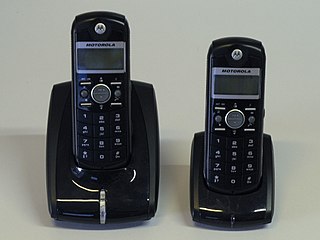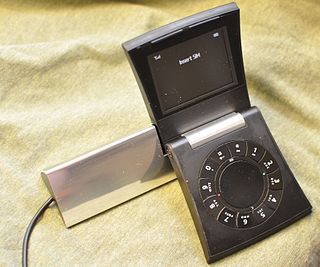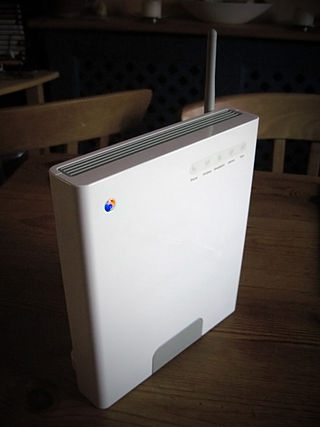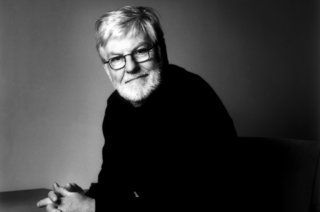
Digital enhanced cordless telecommunications (Digital European cordless telecommunications), usually known by the acronym DECT, is a standard primarily used for creating cordless telephone systems. It originated in Europe, where it is the common standard, replacing earlier cordless phone standards, such as 900 MHz CT1 and CT2.

A telephone is a telecommunications device that permits two or more users to conduct a conversation when they are too far apart to be easily heard directly. A telephone converts sound, typically and most efficiently the human voice, into electronic signals that are transmitted via cables and other communication channels to another telephone which reproduces the sound to the receiving user. The term is derived from Greek: τῆλε and φωνή, together meaning distant voice. A common short form of the term is phone, which came into use early in the telephone's history.

The Trimline telephone is a series of telephones that was produced by Western Electric, the manufacturing unit of the Bell System. These telephones were first introduced in 1965 and are formally referred to as the No. 220 Hand Telephone Sets. The Trimline was designed by Henry Dreyfuss Associates under the project direction of Donald Genaro; the firm had produced the previous post-war desktop telephone types for the American Telephone & Telegraph Company.
corDECT is a wireless local loop standard developed in India by IIT Madras and Midas Communications (www.midascomms.com) at Chennai, under leadership of Prof Ashok Jhunjhunwala, based on the DECT digital cordless phone standard.

A cordless telephone or portable telephone has a portable telephone handset that connects by radio to a base station connected to the public telephone network. The operational range is limited, usually to the same building or within some short distance from the base station.

A business telephone system is a multiline telephone system typically used in business environments, encompassing systems ranging in technology from the key telephone system (KTS) to the private branch exchange (PBX).
The Generic Access Profile (GAP) describes a set of mandatory requirements to allow any conforming DECT Fixed Part (base) to interoperate with any conforming DECT Portable Part (handset) to provide basic telephony services when attached to a 3.1 kHz telephone network.
Bang & Olufsen (B&O) is a high-end consumer electronics company that designs and manufactures audio products, television sets, and telephones, originally from Denmark, founded in 1925 by Peter Bang and Svend Olufsen, who designed a radio to work with alternating current, a product of significance at a time when most radios were still running on batteries.

Serene is a mobile phone produced as a joint venture between Samsung Electronics and Bang & Olufsen. It was released in the last quarter of 2005 in Europe. It was available in select stores throughout the world and cost $1275 (~€1000).
Generic Access Network (GAN) is a protocol that extends mobile voice, data and multimedia applications over IP networks. Unlicensed Mobile Access (UMA) is the commercial name used by mobile carriers for external IP access into their core networks. The latest generation system is named Wi-Fi calling or VoWiFi by a number of handset manufacturers, including Apple and Samsung, a move that is being mirrored by carriers like T-Mobile US and Vodafone. The service is dependent on IMS, IPsec, IWLAN and ePDG.
Mobile VoIP or simply mVoIP is an extension of mobility to a voice over IP network. Two types of communication are generally supported: cordless telephones using DECT or PCS protocols for short range or campus communications where all base stations are linked into the same LAN, and wider area communications using 3G or 4G protocols.
CT2 is a cordless telephony standard that was used in the early 1990s to provide short-range proto-mobile phone service in some countries in Europe. It is considered the precursor to the more successful DECT system. CT2 was also referred to by its marketing name, Telepoint.

The BT Smart Hub is a family of wireless residential gateway router modems distributed by BT for use with their own products and services and those of wholesale resellers but not with other Internet services. Since v 5 Home/Smart Hubs support the faster Wi-Fi 802.11ac standard, in addition to the 802.11b/g/n standards. All models of the Home Hub prior to Home Hub 3 support VoIP Internet telephony via BT's Broadband Talk service, and are compatible with DECT telephone handsets. Since the Home Hub 4, all models have been dual band.
Dual-mode mobiles refer to mobile phones that are compatible with more than one form of data transmission or network.

Headsets connect over a telephone or to a computer, allowing the user to speak and listen while keeping both hands free. They are commonly used in customer service and technical support centers, where employees can converse with customers while typing information into a computer. Also common among computer gamers are headsets, which will let them talk with each other and hear others, as well as use their keyboards and mice to play the game.
Gigaset AG, formerly known as Siemens Home and Office Communication Devices, is a German multinational corporation based in Bocholt, Germany. The company is most active in the area of communications technology. Gigaset manufactures DECT telephones. In 2017, it had 930 employees, revenue of 293 million Euro and sales activities in approximately 70 countries.

Jacob Jensen, was a Danish industrial designer best known for his work with Bang & Olufsen. Jensen designed numerous popular high-end consumer products, developing a functional minimalism style that formed a prominent part of the Danish modern movement. In 1958 he founded the Jacob Jensen Design Studio. Jensen designed for other brands including Alcatel, Kirk, Boform, General Electric, International Gift Corporation, JO-JO, Labofa, Rodenstock, Rosti, and Stentofon. His works have been featured at the Museum of Modern Art (MoMA) in New York City, and have received numerous design awards.

David Whitfield Lewis was a British industrial designer. He is best known for his work for Bang & Olufsen. He was a distinguished member of Royal Designers for Industry. Several of the products he designed are included in the MoMA permanent collection of design.
The charts below compare hardware and firmware features in the FRITZ!Box device range.
The Samsung SGH-F310 Serenata was the successor to the Serene mobile telephone. The device, a collaboration between Samsung and Bang & Olufsen, featured the logotypes of both companies. Designed by David Lewis, it was introduced in October 2007.












